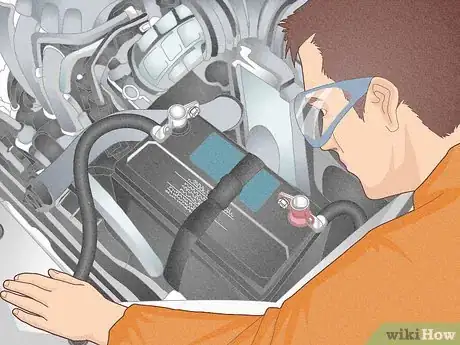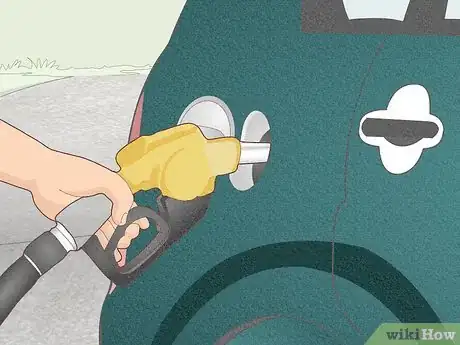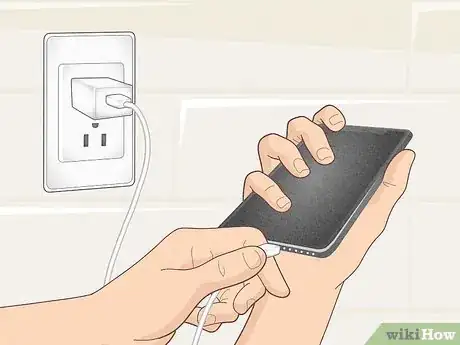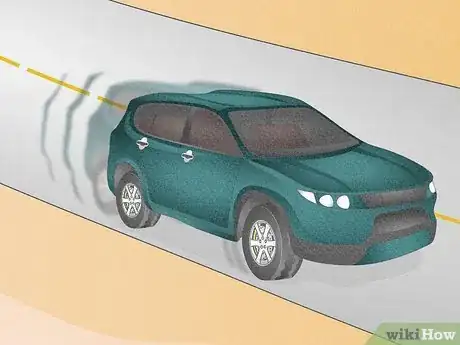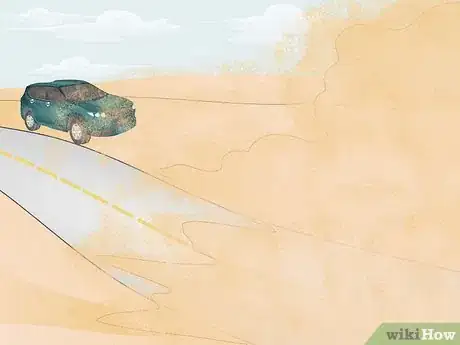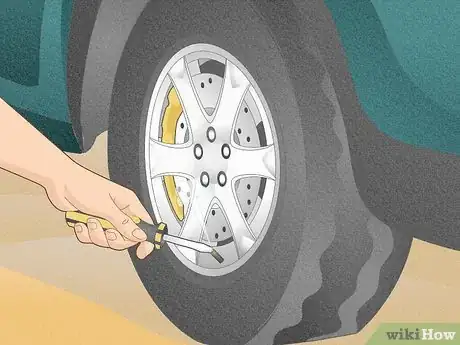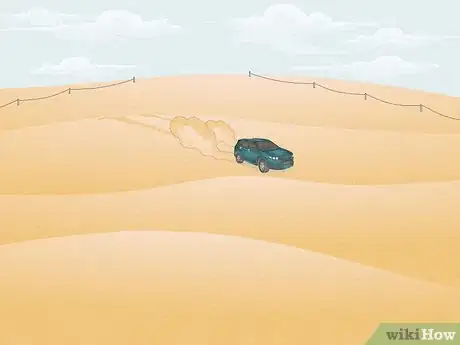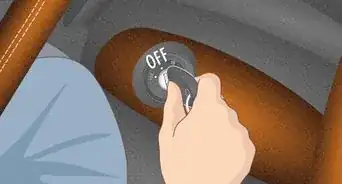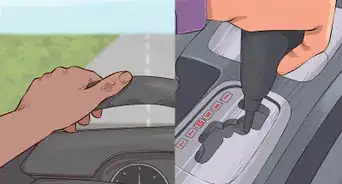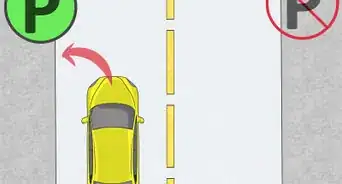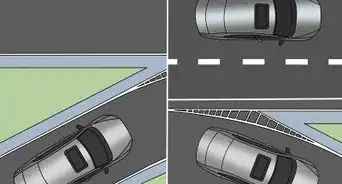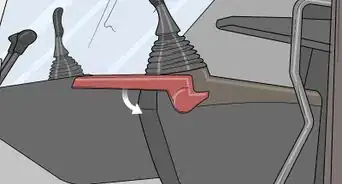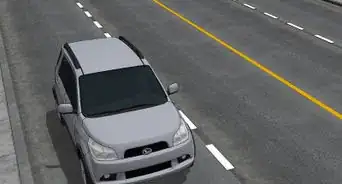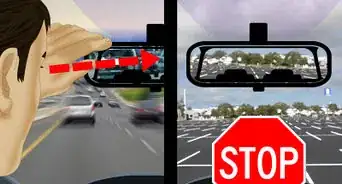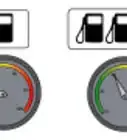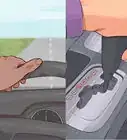This article was co-authored by Ibrahim Onerli and by wikiHow staff writer, Eric McClure. Ibrahim Onerli is a Driving Instructor and the Manager of Revolution Driving School in New York City. His mission is to make the world a better place by teaching safe driving. Ibrahim trains and manages a team of over eight driving instructors. He specializes in teaching defensive driving and stick shift driving.
There are 20 references cited in this article, which can be found at the bottom of the page.
This article has been viewed 12,406 times.
Whether you’re finally taking that road trip to Las Vegas or you’re doing some sightseeing through the Australian Outback, it’s important to know what you’re getting into. Between the dusty conditions and the extreme heat, the desert can be a dangerous place to drive if you aren’t ready for the journey. Make sure that you purchase the necessary supplies ahead of time and get your vehicle inspected before you take off to ensure that your fun journey doesn’t turn into a disaster. So long as you’re prepared though, get ready for some beautiful landscapes and enjoy the ride! but note it can be very dangerous.
Steps
Before the Drive
-
1Get your vehicle inspected by a mechanic before your journey. If you’re heading into a vast desert, take your vehicle to a mechanic to get an inspection and resolve any potential issues.[1] Heat and high temperatures put a lot of pressure on your vehicle, and it could break down if everything isn’t in working order. Ask your mechanic to inspect the following:[2]
- The health of your tires and the tire pressure (high temperatures put extra pressure on the tread).
- Your battery (the heat puts wear and tear on your battery, so it may die if it’s already weak).
- Your fluid levels (adequate levels of brake fluid, coolant, radiator fluid, transmission fluid, and engine oil are all essential for a safe ride).
- Your air conditioning system (if it gives out, you may struggle to cool off in the vehicle).
-
2Pack an emergency kit in case anything goes wrong on the road. Pop your trunk and go through the emergency checklist to make sure you have everything you need. You must be prepared for the worst case scenario, even if you’re extremely unlikely to run into problems on the road. Make sure you have the following items ahead of time:[3]
- Jumper cables.
- A flashlight.
- Road flares.
- A first aid kit.
- A spare tire, jack, and lug wrench.
Advertisement -
3Fill your gas tank up all the way before you head into the desert. As you get close to the desert, stop by a petrol station and fill your gas tank up all the way. Gas stations can be kind of hard to find depending on where you’re driving, and you may not come across one for some time. Keeping your gas tank filled will also ensure that your vehicle has plenty of juice to keep running efficiently.[4]
- Whenever you come across a gas station on your journey, pull over and top off the tank. You never know when the next station will pop up on the horizon, and this gives your vehicle a few minutes to cool off. It’s also a good excuse to grab some snacks and drinks!
-
4Dress for the heat and don’t forget your sunglasses. As you know, the desert has the tendency to get pretty hot and bright. Wear long-sleeved pants and a full-sleeve shirt to protect your skin from the sunlight beaming in through the windows. Throw on sunscreen at least 15 minutes before you go outside of the vehicle, and don’t forget your sunglasses![5]
- A wide-brimmed hat is also a good idea, although you won’t need to wear it in your vehicle.
- This is less important if you’re driving through a desert in the winter or fall and it’s not going to be super hot outside, but you should still bring sunglasses and wear sunscreen.
- Also pack for the cold of night. The temperature in a desert can plummet at night. If you only are prepared for the heat, then you could potentially shiver when it gets too dark.
-
5Bring as much water as you can reasonably carry in the vehicle. Not only will you be more comfortable if you have plenty of water to stay hydrated, but all of the extra water will come in handy if the vehicle breaks down and you’re stranded for a few hours before help can arrive. You’ll also need plenty of water to refill the vehicle’s radiator if it ever gets close to overheating.[6]
- Don’t put cold water in your engine if it’s hot. The abrupt temperature change can damage the vehicle. If you don’t know how to cool down the radiator, a desert emergency is no time to learn. Pull over, pop the hood, and call and wait for help.[7]
- Bring at least 15.5 cups (3.7 liters) of water for each person in the vehicle to drink a day. So if you’re going on a 2-day drive with 3 people in the car, keep at least 5.8 gallons (22 L) of water in the vehicle at all times.[8]
-
6Charge your phone before you leave and pack a spare battery. If something goes wrong on a long stretch of desert road, you’ll need to call for help. Charge that phone to 100% before you get in the vehicle and bring a spare battery pack to charge on the go. Don’t forget your regular charger and an adapter to charge phones in the vehicle if it doesn’t have USB port or charging station.[9]
- If you’re driving through an especially remote portion of the desert, pack a satellite phone. You may not be able to get cell reception on your regular phone depending on where you are.
-
7Bring a satellite phone and PLB if you’re off-roading in remote areas. If everything that can go wrong does go wrong, you’ll need a way to signal emergency services. Purchase and bring a satellite phone that can make calls if you don’t have any cell reception. You should also bring a personal locator beacon (PLB) to automatically signal the police and emergency services and let them know where you are.[10]
- A satellite phone will cost $600-1,700.[11] A PLB will run $350-600.[12] This can be a lot of money up front, but these are mandatory if you plan on doing any adventuring in remote areas. The cost is worth it!
- You typically have to register a PLB where you live so that it can signal the emergency services in your country.[13]
On the Road
-
1Keep the air conditioning on to stay comfortable during the drive. Yes, it’s incredibly obvious, but it’s also super important. Keep the air conditioning on while you’re driving so that everyone stays comfortable. It will also be safer for the driver, since it’s easier to focus and stay alert if you aren’t sweating through your shirt.[14]
- You can bring a few extra handheld fans to keep the air circulating in your vehicle if you’d like.
-
2Stick to main roads and don’t turn into sandy banks or unpaved areas. If you’re driving a normal vehicle, dust can kick up into the engine and block up your transmission. To minimize the wear and tear on your vehicle, stay on paved surfaces and don’t take scenic detours through unpaved areas. It can also be exceptionally hard to turn on a sandy or soft surface, so you may get stuck if you pull into any unpaved areas.[15]
- It’s also typically illegal to take a vehicle off the road in the desert. Not only is it dangerous, but it’s bad for the environment. Just stay on the road if you aren’t in a designated off-road area.[16]
-
3Brake and accelerate slowly to avoid skidding or spinning out. When it gets extremely hot, the asphalt on the road can soften up as it bakes in the sun. This can create something known as “bleeding tar.” If you turn or brake abruptly on bleeding tar, your vehicle may skid or slide as if it were on ice. Stay under the speed limit, move slowly when making turns, and don’t make a ton of abrupt movements on the road to stay safe.[17]
- Driving too fast will also put a ton of pressure on your engine. Your vehicle is more likely to break down or overheat if you’ve got the pedal to the metal in the desert.
-
4Pull over and close the windows if you encounter a dust storm. Depending on where you live and when you’re driving through the desert, you may run into a dust storm. This is where high winds kick up enough dust and sand to impact visibility. If a dust storm crops up on the horizon, pull over, turn your blinkers on, close the windows, and wait it out.[18]
- You’ll know if there’s a dust storm coming. You’ll see the giant plumes of brown and tan dirt flying through the air.
- Dust storms can be pretty big and scary, but they don’t tend to last particularly long. Try not to panic; you’ll be back on the road in no time.[19]
-
5Deflate your tires a little bit if you’re off-roading for fun. If you’re doing some exciting off-roading in an unpaved area, let a little bit of air out of your tires before you start. Just open the valve on each tire and use a screwdriver, key, or tire deflator to press the center of the valve stem to let a little bit of air out.[20] This will keep your vehicle from bouncing off of uneven surfaces and reduce the odds that you damage your tires.[21]
- Use a pressure gauge to double-check your tire pressure before taking off. You still need to stay within your tire’s recommended pressure. So if your maximum pressure is 35 psi, you probably want to shoot for 28-30 psi.
What to Avoid
-
1Stick with your vehicle if it breaks down and don’t wander off. If something does go wrong on the road, don’t take off for that service station you passed 5 miles (8.0 km) back. You could experience heat stroke, get lost, or miss your chance to flag down help for your vehicle. Stay with your vehicle and call a tow truck or mechanic to come to your aid.[22]
- If you can’t contact a tow truck or mechanic, call emergency services to send help.[23]
- If you can’t get reception, just stay with your vehicle and flag down the next vehicle that drives by to get help.
- Pop your hood to let the engine cool off and drop a road flare down behind your vehicle to warn upcoming drivers.
-
2Stay in designated areas if you’re off-roading in the desert. If you’re off-roading, you must drive in designated off-roading areas. Don’t just pull off at an interesting sand bank and start driving in the sand.[24] Not only is it usually illegal to off-road in undesignated areas, but your vehicle can damage the desert’s ecosystem and put wildlife at risk.[25]
- Don’t go off-roading in a standard sedan or hatchback. You must use a vehicle designed for off-road driving, like an ATV, dune buggy, or an off-roading truck or SUV with 4-wheel-drive.[26]
- Do not go off-roading alone or with a single vehicle. If something goes wrong, you’ll need help—especially if you’re in a remote area where you can’t get reception.
-
3Drive around steep grades, standing water, and rough terrain. Don’t drive through any water if you don’t know the depth, don’t tackle steep angles, and steer clear of dangerous terrain. Follow the rules of the road and stay on the off-roading trail if you’re tackling a recreational course. So long as you make sensible decisions behind the wheel, there’s no reason you can’t have a great time off-roading in the desert![27]
- If you're in a vehicle with a manual transmission and you have to drive up a road that's a steeper grade, make sure the car is in first gear. If you're in an automatic, the engine should change the gear on its own, but it should either be D or D1.[28]
- Off-roading trails are designed to be drivable, but the surrounding landscape may not be safe. Stay on course and don’t put yourself in a dangerous situation by wandering off.
- If you have to park somewhere on an incline, move very slowly, and keep your foot on the brake the whole time. Use the handbrake to prevent the car from rolling down the hill.[29]
Expert Q&A
-
QuestionWhat gear should I be in to drive up a steep road?
 Ibrahim OnerliIbrahim Onerli is a Driving Instructor and the Manager of Revolution Driving School in New York City. His mission is to make the world a better place by teaching safe driving. Ibrahim trains and manages a team of over eight driving instructors. He specializes in teaching defensive driving and stick shift driving.
Ibrahim OnerliIbrahim Onerli is a Driving Instructor and the Manager of Revolution Driving School in New York City. His mission is to make the world a better place by teaching safe driving. Ibrahim trains and manages a team of over eight driving instructors. He specializes in teaching defensive driving and stick shift driving.
Driving Instructor In a manual, you should be in first gear. In an automatic you should be in D. Some cars have smaller gears, so it will say D1-D2-D3, and it should be in D1.
In a manual, you should be in first gear. In an automatic you should be in D. Some cars have smaller gears, so it will say D1-D2-D3, and it should be in D1.
Things You’ll Need
- Jumper cables
- Flashlight
- Road flares
- First aid kit
- Non-perishable food
- Water
- Sunglasses
- Sunscreen
- Long-sleeved clothing
- Hat
- Phone
- Phone charger
- Backup battery
- Satellite phone
- Personal locator beacon
- Pressure gauge
References
- ↑ https://www.mdlt.org/discover-learn/you-are-here/desert-safety-tips/
- ↑ http://highdesertdaily.com/2018/07/heat-is-here-check-over-car-before-your-summer-road-trip/
- ↑ https://www.idrivesafely.com/driving-resources/how-to/drive-in-extreme-heat/
- ↑ https://www.mdlt.org/discover-learn/you-are-here/desert-safety-tips/
- ↑ https://www.mdlt.org/discover-learn/you-are-here/desert-safety-tips/
- ↑ https://dld.utah.gov/wp-content/uploads/sites/17/2018/12/Driver-Handbook-2018-2019.pdf
- ↑ https://www.consumerreports.org/cro/news/2010/07/what-to-do-if-your-car-overheats/index.htm
- ↑ https://www.mayoclinic.org/healthy-lifestyle/nutrition-and-healthy-eating/in-depth/water/art-20044256
- ↑ https://www.pe.com/2016/10/05/11-things-to-pack-for-desert-trip/
- ↑ https://www.mdlt.org/discover-learn/you-are-here/desert-safety-tips/
- ↑ https://www.forbes.com/sites/marcwebertobias/2013/03/18/how-and-when-to-buy-a-satellite-phone/#1f44c7ca647d
- ↑ https://www.nytimes.com/2007/07/05/technology/circuits/05basics.html
- ↑ https://www.sarsat.noaa.gov/emerbcns.html
- ↑ https://idaoffice.org/posts/a-car-trip-in-the-desert/
- ↑ https://idaoffice.org/posts/a-car-trip-in-the-desert/
- ↑ https://www.sciencedirect.com/science/article/pii/S1319562X18301153
- ↑ https://dld.utah.gov/wp-content/uploads/sites/17/2018/12/Driver-Handbook-2018-2019.pdf
- ↑ https://ein.az.gov/hazards/dust-storms
- ↑ https://ein.az.gov/hazards/dust-storms
- ↑ https://www.carsguide.com.au/adventure/how-to/how-to-deflate-your-tyres-for-off-roading-69089
- ↑ https://www.hotcars.com/basic-off-roading-tips-and-mistakes-guaranteed-to-get-people-stuck/
- ↑ https://dld.utah.gov/wp-content/uploads/sites/17/2018/12/Driver-Handbook-2018-2019.pdf
- ↑ https://thenewswheel.com/how-to-survive-a-car-breakdown-in-the-desert/
- ↑ https://www.nps.gov/deva/planyourvisit/off-road-driving.htm
- ↑ https://www.sciencedirect.com/science/article/pii/S1319562X18301153
- ↑ https://www.roadandtrack.com/car-culture/travel/advice/a26448/everything-you-need-to-know-to-go-off-road-but-were-afraid-to-ask/#
- ↑ https://www.hotcars.com/basic-off-roading-tips-and-mistakes-guaranteed-to-get-people-stuck/
- ↑ Ibrahim Onerli. Driving Instructor. Expert Interview. 18 November 2019.
- ↑ Ibrahim Onerli. Driving Instructor. Expert Interview. 18 November 2019.
- ↑ https://www.chicagotribune.com/weather/ct-wea-0318-asktom-20160317-column.html
